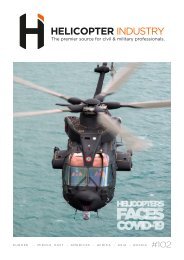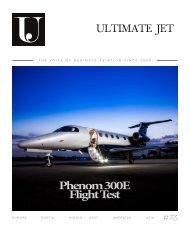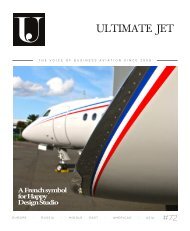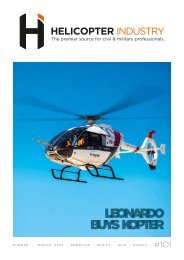Helicopter Industry #103
Create successful ePaper yourself
Turn your PDF publications into a flip-book with our unique Google optimized e-Paper software.
HELICOPTER INDUSTRY I FAREWELL I<br />
0<br />
n September 4th, in front of an audience of officers<br />
and three machines with commemorative livery for the<br />
occasion, the French Navy bid farewell to its last Lynx still<br />
in operation. In addition to the helicopter, the entity also put<br />
its prestigious unit, the 34F, to sleep for a few months. For<br />
41 years, the pair will have criss-crossed the globe to ensure<br />
mainly the mission of anti-submarine warfare.<br />
« It’s a feeling shared between emotion and optimism to see the<br />
departure of an aircraft on which I have flown throughout my<br />
career. Nevertheless, this departure opens a new era and a new<br />
chapter in the history of the Navy ». These few words spoken<br />
by Commander François Chaput, the last commander of the<br />
34F, symbolises the attachment of the Navy and its men to<br />
this aircraft.<br />
The Lynx is the result of a Franco-British commercial<br />
cooperation between Aérospatiale and Westland in its<br />
French version. The Lynx is above all an aircraft whose<br />
design is based on Westland’s experience in on-board<br />
helicopters, particularly the WASP model. Above all, it is a<br />
machine designed by the British, for the British, just like the<br />
car on the other side of the Channel. The feline will thus be<br />
developed with innovative technical solutions to make it a<br />
helicopter particularly suited to boarding. A stocky machine<br />
with a very low center of gravity to give it great stability on<br />
marine platforms, the Lynx is also the only machine to have<br />
a main gearbox (MGB) in the shape of a «crushed pyramid».<br />
This technical design makes it possible to lower the height<br />
of the device. Correlated to the blades and a folding beam,<br />
it will facilitate its storage on board frigates and make it a<br />
helicopter fully in line with the requirements of naval forces.<br />
In addition, it remains the only aircraft to have a pitch change<br />
system whose axis runs through the MGB system at its<br />
center. A mechanism that is totally different from the swash<br />
plates usually found on rotating wings, but has undoubtedly<br />
proven itself since the machine was put into service.<br />
HI I 18









